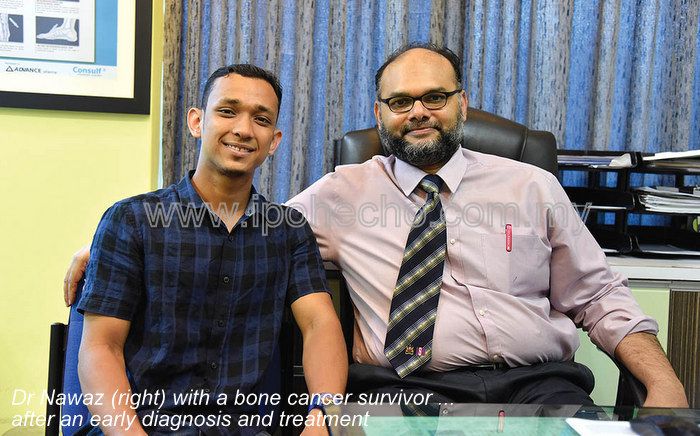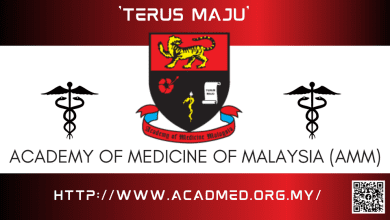

“The war against cancer requires a multidisciplinary approach and Orthopaedic Oncology will be the first line of defence in the Orthopaedic cancers,” declared Dr Nawaz Hussain B. Mohamed Amir, Resident Consultant Orthopaedic Surgeon at KPJ Ipoh Specialist Hospital.
A graduate of USM, Dr Nawaz received his Master’s in Orthopaedics also from USM and continued his subspecialty training in Malaysia’s first and biggest Orthopaedic Oncology unit which is coincidentally in HUSM and later in one of the world’s top oncology hospitals, the Tata Memorial Hospital in Mumbai India, followed by further experiential learning in oncology in Hamburg, Germany, as well as a training in Arthroplasty in Kiel.
Joining KPJ Ipoh Specialist Hospital in 2013, Dr Nawaz has been treating all orthopaedic conditions, although cancers of the bone and soft tissue are his specialty. Dr Nawaz is one of a handful (16 to 18) of Orthopaedic Oncologists in Malaysia and one of two in the northern region. He works with a team of specialists in treating patients who are referred to him.
Dr Nawaz details the signs of bone cancer as bone pain; swelling and tenderness near the affected area; weakened bone leading to fracture; fatigue and unintended weight loss.
The cause of most bone cancer is unknown. A small number of bone cancers have been linked to hereditary factors, while others are related to previous radiation exposure. The most common bone cancers are around the knee and shoulders and afflict younger people aged between five to 25; attributed to growth spurts.
Types of bone cancer
Bone cancers are broken down into separate types based on the type of cell where the cancer began. Osteosarcoma is the most common form of bone cancer. In this tumour, cancerous cells produce bone. This variety of bone cancer occurs most often in children and young adults, in the bones of the leg or arm.
Chondrosarcoma is the second most common form of bone cancer. In this tumour, cancerous cells produce cartilage. Chondrosarcoma usually occurs in the pelvis, legs or arms in middle-aged and older adults.
Ewing sarcoma tumours most commonly arise in the pelvis, legs or arms of children and young adults.
According to Dr Nawaz, each type of bone cancer is treated with its own therapeutic schedule of chemotherapy and radiation, depending on findings in the diagnostic ‘staging’. This is where Dr Nawaz is in the front line as the initial diagnostician who takes the patient’s history, orders the imaging scans, performs the tissue biopsies necessary and with the pathologist, make an accurate diagnosis.
If a malignancy is found, Dr Nawaz will then work with other members of his oncology team in a total treatment plan. From tissue biopsies, he and the medical oncologist will determine chemosensitivity and cycles of chemo drugs or whether only radiation will be effective or a combination of both. All this treatment will inevitably be followed by surgery performed by him, for example, in Osteosarcoma the surgery called wide resection and endoprosthesis, with further chemo postoperatively.
In the case of Chondrosarcoma, only surgery is prescribed. This usually affects 40 to 60-year-olds and in this age group, metastases to the bone from other primary cancers in the body like thyroid, breast, lung, kidney and prostate are also common. Hence the usual protocol for these other cancers now routinely involves a bone scan to customise specific treatment for each patient.
After the whole treatment process is over, will the physiotherapy part come in. This then is the complete teamwork that is required in the Orthopaedic Oncology protocol.
Fortunately, according to Dr Nawaz, most bone cancers when caught early enough and treated, have a five-year survival rate which is promising, for example, in osteosarcoma between 50%-75%. Because the cancer occurs away from major organs and because of pain and swelling, most patients are caught at stage 1 or 2, the survival rate is higher.
Therefore, the admonition from Dr Nawaz is this: if you have pain or swelling of your joints or bones or muscles that doesn’t go away after a few days, go to a doctor and check it out. It may save your life.
Dr Nawaz Hussain B. Mohamed Amir MD(USM), M.Med Ortho (USM) Resident Consultant Orthopaedic Surgeon Suite 1-08, KPJ Ipoh Specialist Hospital 26 Jalan Raja DiHilir, Ipoh. Tel: 05 240 8777 ext. 8316

